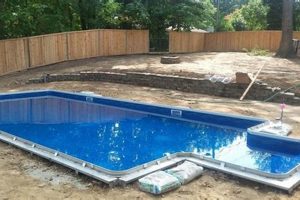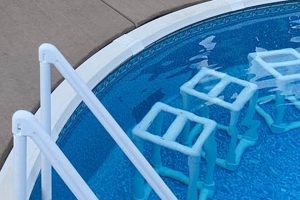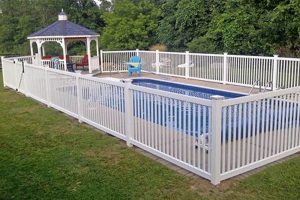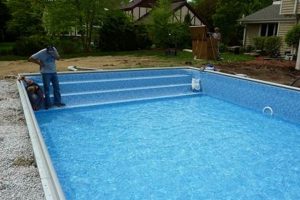The concept involves repurposing intermodal containers into aquatic recreational facilities, often undertaken as a self-directed construction project. This approach utilizes the inherent structural integrity and standardized dimensions of these metal boxes to create a ready-made pool shell. For instance, an individual might procure a used container, reinforce it as needed, apply a waterproof lining, and install necessary plumbing and filtration systems to establish a functional swimming environment.
This construction method presents potential advantages concerning cost and construction time compared to traditional in-ground alternatives. The inherent durability of the steel structure provides a long-lasting base, and the prefabricated nature streamlines the building process. Historically, resourceful individuals have sought innovative ways to utilize readily available materials, and this exemplifies such ingenuity, transforming industrial waste into functional amenities. The practice further aligns with contemporary sustainability goals through the reuse of existing resources.
The following sections will detail critical aspects related to the realization of such a project, including necessary structural modifications, waterproofing techniques, installation of filtration and plumbing, as well as essential safety considerations. Furthermore, aesthetic customization options and relevant regulatory compliance will be addressed.
Essential Considerations for Container-Based Aquatic Installations
Implementing a container-based aquatic installation requires careful planning and execution to ensure structural integrity, water tightness, and user safety. Prioritizing these aspects is paramount for a successful and enduring outcome.
Tip 1: Structural Reinforcement: Assess the container’s condition meticulously. Rust, corrosion, or prior damage may necessitate significant reinforcement. Welding additional steel supports, particularly along the walls and floor, is often required to withstand the hydrostatic pressure exerted by the water.
Tip 2: Waterproofing Measures: Employ a multi-layered waterproofing system. Apply a robust epoxy coating or a durable liner specifically designed for aquatic environments. Properly sealing all seams and penetrations is critical to prevent leaks and corrosion.
Tip 3: Plumbing and Filtration Integration: Plan the plumbing and filtration system layout meticulously. Ensure adequate water circulation and efficient removal of debris. Install a properly sized pump and filtration unit to maintain water quality and hygiene.
Tip 4: Safety Compliance: Adhere to all relevant local building codes and safety regulations. Install safety features such as ladders, non-slip surfaces, and fencing to prevent accidents and ensure user well-being.
Tip 5: Thermal Management: Consider thermal insulation to mitigate temperature fluctuations. Applying insulation to the exterior of the container can help maintain a consistent water temperature and reduce energy consumption for heating or cooling.
Tip 6: Ground Preparation: Properly prepare the ground or foundation beneath the container. Ensure a level and stable base to prevent settling or shifting, which could compromise the structure and waterproofing.
Tip 7: Electrical Safety: Employ a qualified electrician to install all electrical components, including lighting, pumps, and heating systems. Grounding the container and using GFCI outlets are essential safety precautions.
Careful attention to structural integrity, effective waterproofing, appropriate plumbing and filtration, adherence to safety standards, and thermal management are all necessary for a long-lasting and secure structure. Thorough planning and diligent execution are critical for a successful build.
The following sections will focus on the aesthetic possibilities and maintenance considerations, thus providing a broader perspective for prospective builders.
1. Structural Integrity
Structural integrity is paramount when repurposing intermodal containers into aquatic recreational facilities. These containers, designed for cargo transport, undergo significant stress from water pressure when used as pools. Failure to adequately address potential structural weaknesses can lead to catastrophic failure and potential harm.
- Hydrostatic Pressure Resistance
A container, when filled with water, experiences substantial outward pressure on its walls and floor. Original container design does not account for this constant, distributed load. Reinforcement, such as welding additional steel supports (ribs) both internally and externally, is necessary to counteract this pressure. The spacing and thickness of the supports must be calculated based on the dimensions of the container and the desired water depth.
- Corrosion Mitigation
Exposure to water, especially chemically treated pool water, accelerates corrosion. Existing rust must be removed, and the metal surfaces treated with rust inhibitors and protective coatings. Welding introduces additional areas susceptible to corrosion, necessitating thorough surface preparation and sealing. Consideration must be given to selecting materials that are compatible with the intended pool chemicals (chlorine, salt, etc.) to minimize galvanic corrosion.
- Foundation Stability and Support
The ground or foundation beneath the container must be level and capable of bearing the considerable weight of the water-filled container. Uneven settling can introduce stress concentrations, potentially leading to structural failure or leaks. A reinforced concrete pad or a compacted gravel base is commonly used to distribute the load evenly and prevent ground movement. Proper drainage should be implemented to prevent water accumulation around the base, further minimizing corrosion risk.
- Welding Quality and Expertise
Welding is frequently required for structural reinforcement and attachment of fittings (plumbing, ladders, etc.). Inadequate welding practices can create weak points and stress risers, compromising the overall structural integrity. Certified welders with experience in steel construction are essential. Welds must be inspected for porosity, cracks, and proper penetration to ensure they meet relevant standards.
In summary, maintaining structural integrity is not merely a cosmetic concern; it is a fundamental safety imperative for a successful and long-lasting diy shipping container pool project. Addressing hydrostatic pressure, mitigating corrosion, ensuring foundation stability, and employing qualified welders are critical steps. Neglecting any of these facets can lead to structural compromises and ultimately, project failure and risk of injuries.
2. Watertight Sealing
Watertight sealing constitutes a critical element in the construction of container-based aquatic installations. The integrity of the pool fundamentally depends on preventing water leakage, which can undermine the structural stability of the container, corrode the metal, and cause environmental damage. Compromised sealing invites a cascading series of problems. For instance, a small leak can introduce moisture between the container’s steel shell and any internal liner, accelerating rust formation. This corrosion weakens the container walls, potentially leading to structural failure over time. Furthermore, escaping water can erode the surrounding ground, destabilizing the foundation and causing the container to shift or settle unevenly. The selection of appropriate sealing materials and application techniques is therefore not merely a detail, but a fundamental requirement for a successful implementation.
Various methods exist to achieve the necessary level of impermeability. One common approach involves applying multiple layers of epoxy-based coatings, specifically designed for submerged environments. These coatings form a resilient barrier against water penetration and chemical attack. Another popular technique involves the installation of a flexible pool liner, typically made from reinforced PVC or similar materials. The liner is custom-fitted to the interior of the container and sealed at all seams to create a watertight enclosure. Careful attention must be paid to sealing around any penetrations in the container walls, such as plumbing fittings or lighting fixtures. Improper sealing at these points represents a common source of leaks. A real-world example highlights the importance of diligent sealing practices: a project where insufficient seam welding led to rapid and extensive rust formation. In this instance, the owner had to completely disassemble the pool, re-weld, and reseal all the seams. It is also important to consider the long-term effects of chemical exposure when selecting sealants.
In conclusion, achieving watertightness in a shipping container aquatic environment demands a comprehensive approach. The selection of suitable sealing materials, meticulous application techniques, and ongoing inspection and maintenance are essential for preventing leaks, preserving structural integrity, and ensuring the long-term viability of the installation. This facet underscores the importance of professional guidance, especially when dealing with the complexities involved in modifying shipping containers for specialized purposes. Overlooking this critical aspect can lead to premature failure and costly repairs, ultimately negating the cost savings initially sought through this alternative construction method.
3. Filtration System
A filtration system is not an optional accessory but an indispensable component of a repurposed shipping container pool. Its absence invariably leads to unsanitary conditions, posing health risks to users and accelerating degradation of the pool structure. The enclosed nature of a container pool, coupled with its often smaller water volume compared to conventional in-ground pools, makes it particularly susceptible to rapid contamination. Without effective filtration, debris, organic matter, and bacteria accumulate quickly, fostering algae growth and creating an environment conducive to waterborne diseases. This, in turn, necessitates frequent and potentially costly water replacement, negating any initial savings gained through the construction method. The significance of the filtration system, therefore, stems from its direct impact on water quality, user safety, and the long-term economic viability of the endeavor. An improperly sized or maintained filtration system leads to a cycle of water quality issues, increased chemical usage, and ultimately, a less-than-satisfactory aquatic experience.
Selecting an appropriate filtration system involves considering factors such as pool volume, usage frequency, and environmental conditions. Cartridge filters, sand filters, and diatomaceous earth (DE) filters represent common choices, each offering varying degrees of filtration efficiency and maintenance requirements. A smaller container pool used infrequently might suffice with a cartridge filter, while a larger, heavily used pool likely necessitates a sand or DE filter for optimal water clarity. The filtration system’s plumbing also demands careful attention. Correct pipe diameter and pump sizing ensure adequate water circulation, preventing stagnant areas that harbor contaminants. Furthermore, integrating a skimmer to remove surface debris and a vacuum system to clean the pool floor enhances the overall effectiveness of the filtration process. Examples of successful DIY container pool projects highlight the importance of over-engineering the filtration system rather than underestimating its capacity. Many builders opt for filtration systems rated for larger pools to provide a margin of safety and ensure consistently clean water.
In conclusion, the filtration system serves as the cornerstone of a clean, safe, and sustainable container pool. Its proper selection, installation, and maintenance directly influence water quality, user health, and the overall longevity of the project. Failing to prioritize this critical element renders the pool unusable and ultimately a liability. Therefore, dedicating ample time and resources to researching and implementing a robust filtration system is not merely advisable but absolutely essential for the success of any such project.
4. Safety Compliance
Safety compliance is not a peripheral concern but an integral component when repurposing shipping containers into aquatic recreational installations. Regulatory adherence minimizes risk, protects users, and mitigates potential legal liabilities. A failure to conform to established safety standards can result in serious injuries or even fatalities. Therefore, understanding and implementing appropriate safety measures are paramount throughout all phases of the design, construction, and operation of such projects.
- Barrier Requirements and Access Control
Local building codes typically mandate specific barrier requirements around swimming pools to prevent unauthorized access, especially by young children. This often involves installing a fence of a minimum height with self-closing and self-latching gates. The specific requirements vary depending on location and jurisdiction, necessitating thorough research of local regulations. In the context of container pools, adapting these requirements may present unique challenges, such as integrating the container walls into the barrier design while ensuring compliance with gate specifications. Failure to adhere to these regulations exposes owners to legal penalties and increases the risk of drowning incidents.
- Electrical Safety and Grounding
The proximity of water and electricity poses significant hazards, requiring strict adherence to electrical safety standards. Proper grounding of the container structure is essential to prevent electrical shock in the event of a fault. All electrical components, including pumps, filters, and lighting, must be installed by a qualified electrician and conform to relevant electrical codes. Ground Fault Circuit Interrupters (GFCIs) should be used to protect circuits near the pool, providing an added layer of safety by quickly cutting off power in the event of a ground fault. Neglecting these electrical safety precautions can have deadly consequences.
- Structural Integrity and Load-Bearing Capacity
Ensuring the structural integrity of the container and its foundation is critical to prevent collapse or failure. The added weight of water exerts significant pressure on the container walls and floor, requiring adequate reinforcement and support. A structural engineer should be consulted to assess the container’s load-bearing capacity and recommend necessary modifications to meet safety standards. Improper structural modifications can compromise the container’s integrity, leading to catastrophic failure and potential injury. Regular inspections should be conducted to identify any signs of structural weakness or corrosion.
- Water Quality and Sanitation
Maintaining proper water quality and sanitation is essential to prevent the spread of waterborne illnesses. Regular testing of the water is necessary to ensure appropriate levels of chlorine or other sanitizing agents. The filtration system must be properly sized and maintained to remove debris and contaminants. Local health codes may dictate specific requirements for water quality and sanitation, including minimum levels of disinfectant and maximum levels of bacteria. Neglecting these water quality standards can lead to health risks for pool users, ranging from skin irritations to serious infections.
In conclusion, safety compliance is a non-negotiable aspect of container pool construction. Adhering to barrier requirements, implementing robust electrical safety measures, ensuring structural integrity, and maintaining water quality are all essential for creating a safe and enjoyable aquatic environment. Failure to prioritize these safety considerations not only exposes users to unnecessary risks but also carries significant legal and financial consequences. A comprehensive understanding of relevant regulations and a commitment to implementing appropriate safety measures are paramount for responsible container pool ownership.
5. Aesthetic Customization
Aesthetic customization represents a critical component in the realization of a shipping container aquatic facility, directly affecting the overall value and usability of the project. While the fundamental structure offers a pragmatic solution for creating a swimming environment, its inherent industrial appearance often necessitates modifications to achieve visual appeal and integration with the surrounding landscape. Neglecting the aesthetic dimension can result in a stark contrast between the utilitarian container and the desired recreational setting. The extent of customization impacts not only the visual appearance but also influences user experience and perceived value. For instance, a container pool left unadorned may feel out of place or even visually jarring, deterring potential users and diminishing the enjoyment derived from the aquatic amenity.
Numerous customization techniques can be employed to transform a bare shipping container into an aesthetically pleasing pool. Exterior cladding using wood, composite materials, or stone veneers can effectively conceal the container’s metal surface, creating a more natural or sophisticated look. Interior finishes such as tiling, textured coatings, or custom liners can enhance the pool’s visual appeal and provide a comfortable surface for swimmers. Landscaping plays a crucial role in integrating the pool with its surroundings, using plants, rocks, and other features to create a cohesive and inviting environment. Lighting is also a significant factor, with strategically placed lights enhancing the pool’s ambiance and extending its usability into the evening hours. An example demonstrates the impact of aesthetic customization: a repurposed container with basic paint and minimal landscaping was compared to a similar project featuring extensive wood cladding, custom tiling, and carefully planned landscaping. The latter project, despite having similar construction costs, commanded a significantly higher resale value and generated greater user satisfaction.
In conclusion, aesthetic customization is not merely an optional add-on but a fundamental aspect of container pool construction. It transforms a basic metal box into a visually appealing and functional recreational space. The level of customization directly influences the pool’s perceived value, user experience, and integration with the surrounding environment. Addressing the aesthetic dimension enhances the usability of the container pool and justifies the effort and resources invested in the project. The visual appeal can be as valuable to the longevity and satisfaction as the structural elements.
Frequently Asked Questions
The following addresses common inquiries concerning the implementation of aquatic facilities utilizing intermodal containers. Information presented is intended for informational purposes and should not be construed as professional engineering or legal advice.
Question 1: Is a building permit required for a shipping container aquatic facility?
Generally, a building permit is mandatory prior to the commencement of construction. Specific regulations vary depending on local jurisdictions and may encompass zoning requirements, structural specifications, and safety standards. Consultation with local authorities is advised to ensure compliance.
Question 2: What modifications are necessary to ensure the structural integrity of a shipping container used for aquatic purposes?
Reinforcement of the container structure is often required to withstand the hydrostatic pressure exerted by the water. This may involve welding additional steel supports to the walls and floor, as well as reinforcing the container’s corners. A qualified structural engineer should assess the specific needs of each project.
Question 3: What waterproofing methods are suitable for a shipping container aquatic environment?
Effective waterproofing is crucial to prevent leaks and corrosion. Common methods include applying multiple layers of epoxy-based coatings or installing a durable pool liner specifically designed for aquatic applications. All seams and penetrations must be properly sealed to ensure a watertight environment.
Question 4: What considerations are essential when selecting a filtration system for a shipping container pool?
The filtration system must be adequately sized to maintain water quality and prevent the build-up of debris and bacteria. Factors to consider include pool volume, usage frequency, and environmental conditions. Cartridge filters, sand filters, and diatomaceous earth (DE) filters represent common options.
Question 5: Are there specific safety regulations that must be adhered to when building a shipping container aquatic facility?
Adherence to local building codes and safety regulations is essential. This typically involves installing a barrier to prevent unauthorized access, ensuring proper electrical grounding, and maintaining appropriate water quality standards. Consultation with local authorities is necessary to ensure compliance.
Question 6: What is the typical cost associated with constructing a shipping container aquatic installation?
Costs vary significantly depending on the size of the container, the extent of modifications, and the materials used. Factors such as structural reinforcement, waterproofing, filtration, and aesthetic customization influence the overall cost. Detailed project planning and accurate cost estimation are crucial.
In conclusion, repurposing intermodal containers into aquatic facilities necessitates meticulous planning, adherence to safety regulations, and diligent execution. Consultation with qualified professionals is advised to ensure a successful and compliant outcome.
The following article sections will provide additional resources for further guidance.
Concluding Remarks on DIY Shipping Container Pools
The preceding discussion explored the repurposing of intermodal containers into aquatic installations. Critical aspects encompass structural reinforcement to withstand hydrostatic pressure, implementation of robust waterproofing measures, integration of appropriate filtration systems for water quality maintenance, and adherence to stringent safety regulations to safeguard users. Aesthetic customization influences the perceived value and usability of the completed structure.
The construction of diy shipping container pool demands meticulous planning, diligent execution, and a comprehensive understanding of relevant engineering principles and regulatory requirements. Prospective builders should prioritize safety and consult with qualified professionals to ensure a successful and compliant project outcome. The long-term success of such ventures depends on thorough preparation and a commitment to responsible construction practices.







